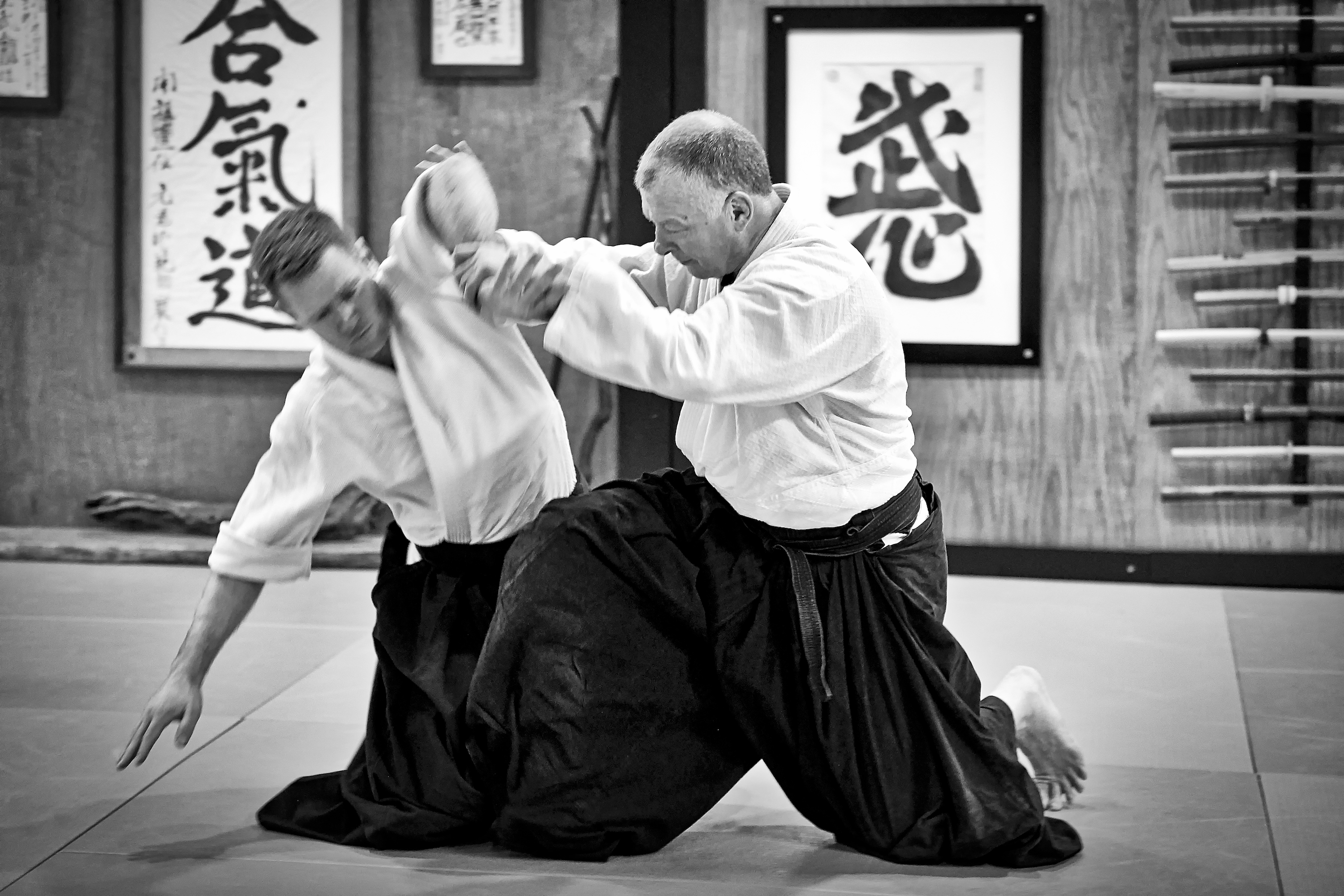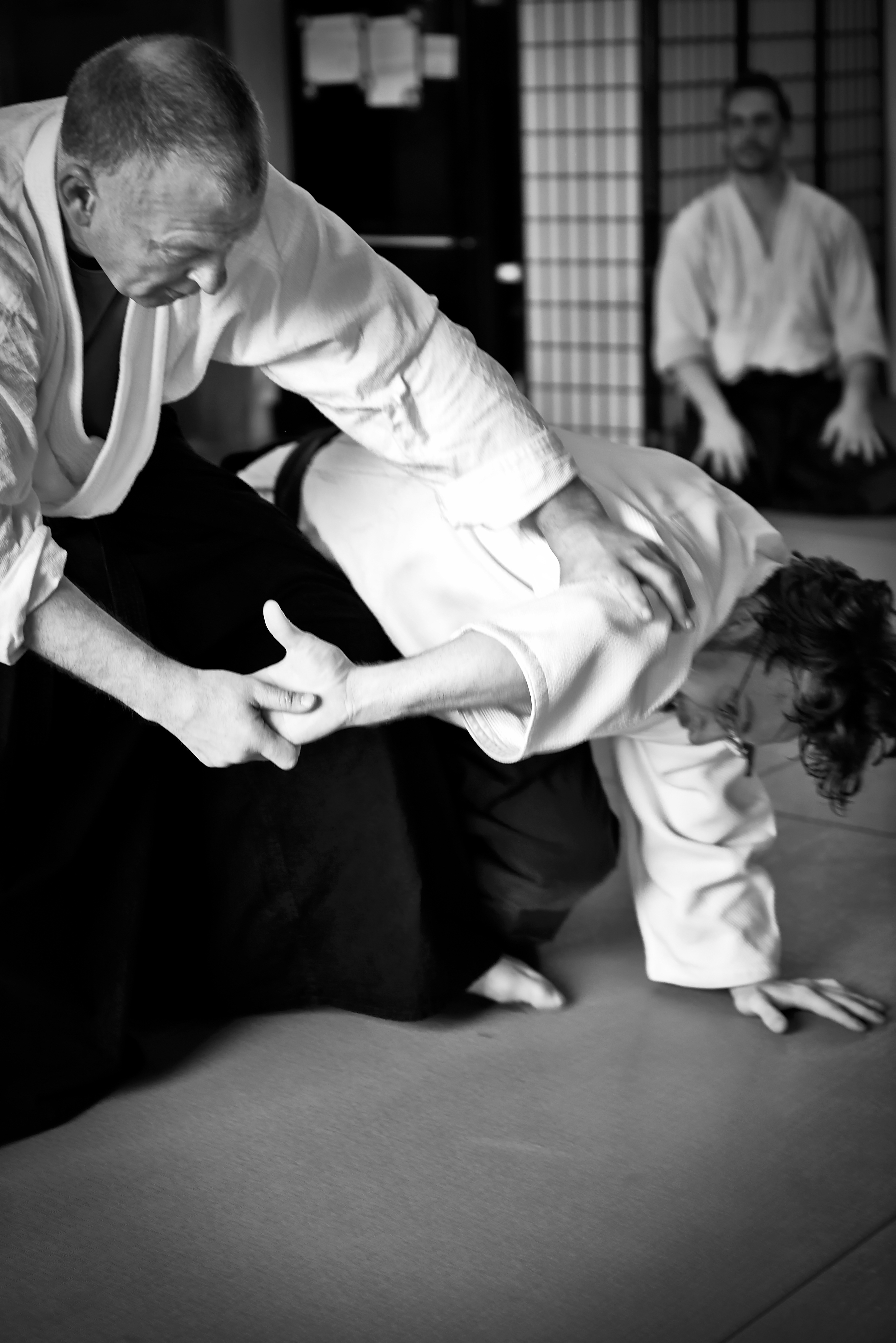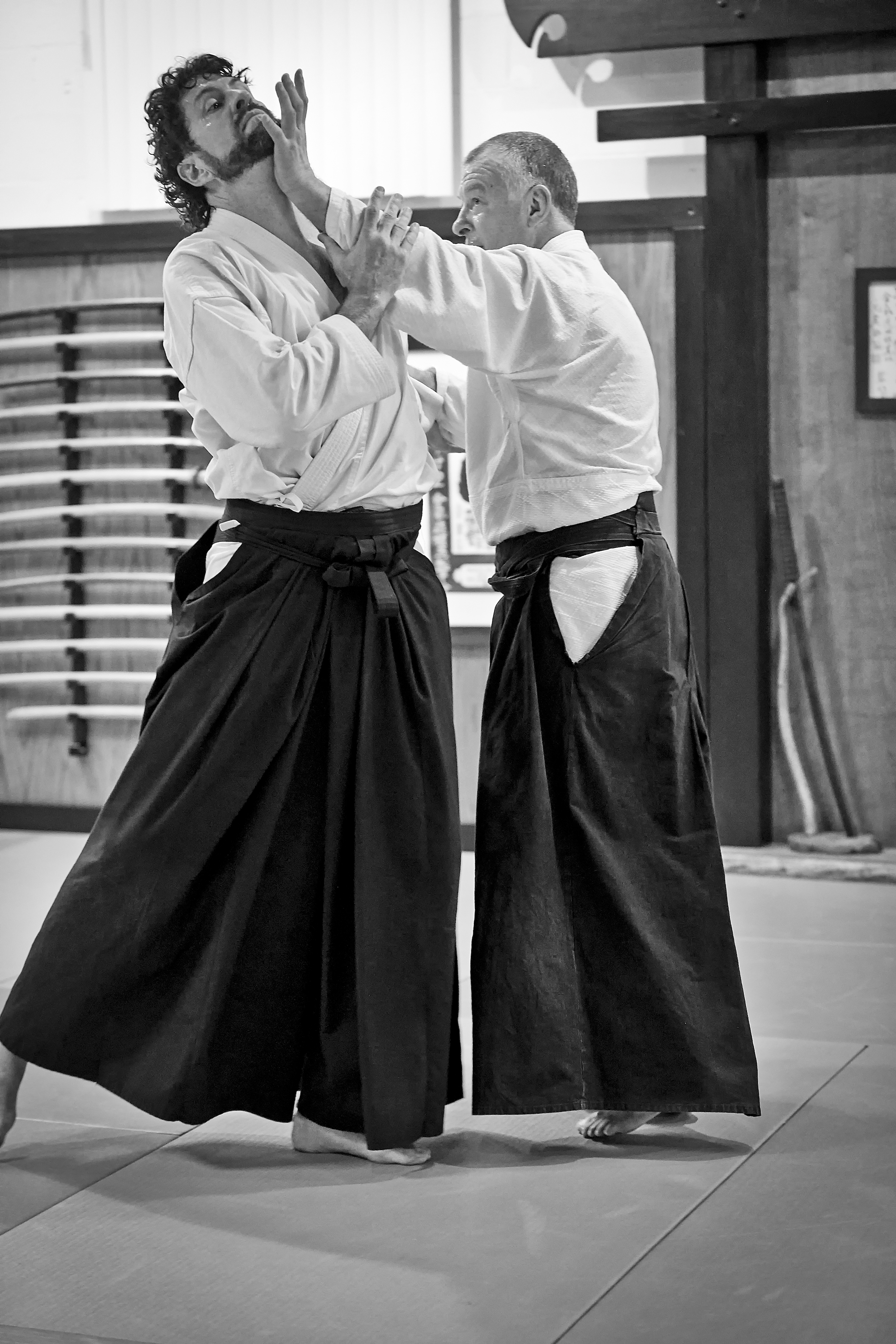Bruce Bookman Sensei is the chief instructor of Tenzan Aikido in Seattle, Washington and one of the most highly respected aikido instructors in the United States. He became the youngest aikido black belt in America at the age of 15 while studying under Yoshimitsu Yamada Shihan at New York Aikikai in the 1970s, and now runs one of the world’s most successful aikido dojos with students ranging in age from four to seventy. Bruce spoke with Aikido Journal about his unique aikido journey, building his dojo, his cross-training experiences, and his perspective on the future of aikido. This is the final part of our four-part interview, which has been edited for length and clarity. The first part is here, the second part is here, and the third part is here.
The fantastic photos accompanying this article are contributed by Bill Aquino, who captured these shots at Bruce Bookman’s February 2018 seminar at Aikido Chuseikan of Tampa Bay.
Josh Gold (Aikido Journal): You’re a very accomplished Aikido instructor, you have a very successful dojo, and you’ve got a pretty unique perspective on the Aikido world, especially in the United States. You’ve been practicing the art since 1970 and here we are now in 2018. What do you think about the current state of aikido? As we look forward, do you have any thoughts on what we can do to make the art as healthy as possible and ensure it flourishes well into the future?
Bruce: That’s a very interesting question with many facets to it. I believe that every person who studies aikido has to ask themselves, “Why do I do aikido?” Every teacher has to ask the same question: “What do I hope to gain from this art? What am I willing to give? How much of a commitment will I make? What result would I like to have? Do I want to lose a few pounds and have an interesting way to build physical fitness? Do I want to learn self-defense? Do I want to become a mixed martial artist, and use aikido as a vehicle for that? Is it a spiritual thing? Do I want to learn to meditate and have something like a moving meditation practice? What is meditation anyway? Is it a way to be spiritual?” You have to answer those questions before you can really present aikido in a way that’s palatable to the general public and helps integrate it into society in a way that’s meaningful.

In my own teaching, I’ve only really begun to understand my goal clearly in recent years. I am trying to create a dojo that I would have loved to be a part of when I first started, and up through my teenage years, as well as a young adult. And now, as an older person, I ask myself, “What kind of a place would I like to be in? What kind of a dojo would I like to take part in?” The answer to that question, for me, is that I love the physicality that aikido puts you in. I love how aikido tempers you in a martial way even though it’s not a “hardcore” martial art. I want strong self-defense skills from being involved in aikido. And if the brown belt from the karate dojo comes in and does some kind of sparring work with me, I’d like to be able to relate to them with aikido.
I like the term you used: “martial tempering.” Can you briefly share your thoughts on that concept in a bit more detail?
I don’t expect myself or my students to be able to go into the octagon, and do Tai-no-Henko on somebody, or have some mystical ability where we can wave our hand and put someone down onto the floor, or hold them with one finger. I think aikido gets a bad reputation from that kind of thing. I wish it would stop. Some people get technical with aikido and work on combative elements in their practice, and because of this, there’s the tendency for others to judge them and say, “Well, they’re not being spiritual.”
I think you can uphold the ethical and spiritual principles of aikido and still have technical answers. There’s nothing inherently spiritual about bad technique or sloppy technique. And there’s nothing non-spiritual about good technique. Why can’t you be a really good technician and be spiritual?
Even though the classical aikido practice tends to use fairly stylized attacks, one can learn about navigating the center line of an attack and applying more or less pressure. The techniques of aikido condition you, the practitioner, the way a baker kneads bread. Both uke and nage grow stronger from the encounter. Good practice helps a person with timing, posture, stamina and hopefully with some grit, all qualities that are necessary for a martial encounter, including a heightened sense of perception and a sense of overall well-being. I find that aikido practice creates a void in my consciousness that makes room to include a spiritual dimension.
I see aikido as a way to use a martial medium to temper ourselves to be more effective when faced with the challenges of ordinary daily life even if we never get physically attacked.

Thank you for sharing your point of view on that. Your dojo is great example of a diverse and thriving aikido community. What approach have you taken as a chief-instructor that’s led you to be so successful in this endeavor?
In my dojo, my goal is to run a place where the instructor has integrity and sees both the student, and what they’re coming in for. I have special one-on-one sessions with all of my students where they sign up to come in and talk to me for 15 minutes. I met with 100 of my adult members over the course of two weekends and talked to them about their goals for aikido, what they’d like to see in their practice, and how best they can adjust their practice to focus on those things. It teaches me a lot about what they’re there for, and how to help them to achieve what they’d like to get out of the practice. At the same time, I give them an opportunity to tell me how can we make the dojo a better place to practice. And while they can say whatever they want, I warn them that I won’t necessarily adopt the suggestions. But if 20 people come in and say the same thing, I listen.
Ultimately, for me, aikido is a spiritual path. Everyone has a purpose in life, something that they’re put here to do; however glamorous or unglamorous it may be. I’ve really thought about what my purpose is, and I think I found it. I teach aikido–this is what I’m supposed to do.
Sometimes I feel like I’m getting tired of teaching children, but the children keep coming in. Now we have 200 kids. It’s tiring and I’m 60 years old now. At times I think I really need to hand this over, but it never seems to work out. I can’t ignore my dharma. I’m supposed to work with kids. I’m supposed to work with adults. I’m supposed to be doing exactly what I’m doing. And even if aikido isn’t your dharma, it can help you to discover your dharma. So, for me, that’s what aikido means. This is the value of studying aikido.
In all of this, as aikido teachers, and as aikido students, we have to take a look at this vast, amazing art of aikido, and find where we fit in it, and where’s the best place for us to do it. Is it in somebody else’s dojo or in our own dojo? What type of emphasis should there be in our practice? There has to be some sort of a baseline for a person to become a teacher, but after that baseline has been met, there are many kinds of gifts that people impart to their students, and people have different reasons for doing the art. You can’t really pass judgment that easily.
I think that’s right.
So how does it settle into America, and how can we get more people involved in aikido? I don’t think we can have a goal to have more people involved. Maybe it’ll die out. We can’t be attached. We can’t try to recruit people just because we’re professionals and we have to make a living, or because we have some belief that everybody ought to be doing it.
One thing I love about Amma’s teaching, and about what I’ve learned from Hinduism, is that it creates bad karma to convince somebody else to move from their own dharma. They’re doing that for a reason, and it shouldn’t be disturbed. It’s not my job to convince people to do aikido–it’s only for me to show them what I do. I’d like to see the dojo continue to grow and prosper, and I feel very blessed that there are so many people there. I hope it continues, but all I can do is show people what I do, and hopefully they’ll find it attractive.
I do spend a fair amount of my time trying to show people what it is that we do, rather than saying, “You should do it.” It’s more like saying, “Are you interested in this? This is what we do.” And if they’re not, fine. And if it comes to be some day that everybody quits the dojo, I can pick up my books and do accounting again. That’s better than trying to be a salesman all the time.

Thank you so much for your time, Sensei. I really enjoyed our conversation and I’m delighted we can share your experience and insights with the Aikido Journal community.
I’m so honored that you’re here to interview me, and that you’ve come out to Seattle to check out our dojo and to see what we’re doing. I’d again like to encourage you to do what you’re doing. I see you’re opening the lines of communication and helping aikidoists to know what’s available, you’re helping people to understand the benefits of cross-training, and giving people exposure to a broad spectrum of what aikido can be. Thank you for that.













In aiki condition, of course it will be easy to practice boxing, BJJ, or getting an Indian Treasure’s hug.
Sensei:
Thank you for sharing your wisdom with us. I especially like, “One thing I love about Amma’s teaching, and about what I’ve learned from Hinduism, is that it creates bad karma to convince somebody else to move from their own dharma. They’re doing that for a reason, and it shouldn’t be disturbed. ” Those are my thoughts, but I could not articulate it as well as you do. Mahalo
Hiroshi
Thank you for sharing your experience.
Really helpful in clarifying my own thoughts.
Hi Bruce, I appreciated this article, especially your thoughts on dharma, although I do think that your understanding of the term might be a little different to mine. Conversion is a real thing in Hinduism and it based on choosing what we find is the most reasonable account of reality. People may not proselytize but they do convert. As such, it isn’t about discouraging ‘shoulds’ once people are signed up. There are should after all within our art, without which aikido wouldn’t be aikido. How you define ‘spiritual’ was also interesting, if somewhat misguided. While it’s not unreasonable to say ‘teaching aikido is spiritual for me,’ I would love to know, then, which parts or in what way one way of teaching is spiritual and others are not. I know dozens of people for who wouldn’t know what ‘the spirituality of teaching aikido’ means. I also beg to differ with you when you say that there’s nothing inherently spiritual about sloppy technique. I think, here again, the answer would have to be ‘it depends.’ It depends on your definition of spirituality and how it is practiced on the mat. It’s also highly questionable whether ‘good technique’ is inherently spiritual, since you haven’t defined what ‘good’ means. In this interview, it appears to mean the same thing as spiritual, which means you haven’t proven anything other than share your opinion that ‘A is A’ or ‘the spiritual is good, the good is spiritual.’ For me, neither sloppy nor genius technique is good if it comes with the hubris of overweening pride. Training each day should enable us to get rid of competitive and comparative thoughts, so that we continue to grow into what it means to be more human, which, I believe, is the purification O-Sensei taught. In that sense, which you may also share, aikido can help us meet the challenges of daily life.
I LOVE this article.
Thank you Josh for continuing to interview such dedicated and interesting instructors! Thank you Bruce for many inspiring insights and thoughts.